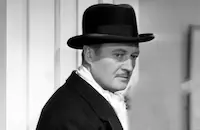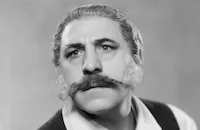In Old Arizona
Brief Synopsis
Cast & Crew
Raoul Walsh
Edmund Lowe
Dorothy Burgess
Warner Baxter
Farrell Macdonald
Fred Warren
Film Details
Technical Specs

Synopsis
The Cisco Kid is a gay caballero whose flair for dramatic thievery and penchant for dangerous trysts keep him just one step ahead of Sgt. Mickey Dunn. The Kid's reputation has preceded him when he approaches the local stagecoach, and he needs to fire only two warning shots to wrest the Wells Fargo box from the driver. His infatuation with a Mexican girl named Tonia María exposes him to near-capture, because of the señorita's double-dealing association with Dunn. Eventually, a showdown becomes imminent, and the Kid exacts a final revenge by framing Tonia so that Dunn shoots her by accident, while the Kid rides laughing off into the sunset.

Cast

Edmund Lowe

Dorothy Burgess

Warner Baxter

Farrell Macdonald
Fred Warren

Henry Armetta
Frank Campeau

Tom Santschi
Pat Hartigan
Roy Stewart
James Bradbury Jr.
John Dillon
Frank Nelson
Duke Martin
James Marcus
Joe Brown

Alphonse Ethier

Soledad Jiménez
Helen Lynch
Ivan Linow
Crew

Film Details
Technical Specs

Award Wins
Best Actor
Award Nominations
Best Cinematography
Best Director
Best Picture
Best Screenplay
Articles
In Old Arizona
Actually, in his initial print and screen incarnations, the Kid was not even clearly identified as Mexican; that would come later in the series. The character started life in a short story by O. Henry (William Sydney Porter), "The Caballero's Way," published in 1907. In that tale, the Kid was not the amiable Robin Hood of the Old West of movie and TV fame but a notorious desperado based in part on legends around Austin, Texas, of gambler and gunman Ben Thompson; the character's real name is revealed to be the decidedly non-Mexican Goodall. In this film version, Baxter is given thick curly hair and a dashing mustache over plenty of skin-darkening make-up, and he uses an excruciating fake Latino accent, but at one point he also claims to be Portuguese. In the film, as in the story, the Kid also does not have the humorous (and very stereotypical) sidekick who later would serve as his constant companion and comic relief.
The plot of In Old Arizona concerns the Kid's adventures as an amiable rogue in love with the fiery and untrustworthy Tonia Maria, giving rise to a love song that established early in sound pictures the tradition of the singing cowboy. Tonia Maria, however, soon has her head turned by Army Sgt. Mickey Dunn and joins him in a plot to capture the Kid.
Although the use of sound was innovative for its time, the technology's limits are still apparent in this production. Warner Brothers studio had ushered in the end of the silent era with The Jazz Singer (1927), and rival studio Fox, which had developed its own sound system, was eager to ride the crest of the wave. The film was started by director Raoul Walsh, who had a justified reputation for action sequences, but camera movements were still restricted by the demands of sound recording. As a result, there are just a handful of legitimate tracking shots, while the actors are required to deliver their lines in static camera set-ups. Tom Barry's nominated screenplay had plenty of zing and raunchy pre-Code dialogue, but the cast was apparently directed to deliver their words slowly and emphatically with odd spaces between lines to avoid any overlap.
Walsh was originally slated not only to direct but to play the Cisco Kid himself. Unfortunately, he lost both opportunities because of an accident early on in production: a jackrabbit jumped through the windshield of his car and cost him an eye (resulting in the eye patch with which he was so closely identified). Irving Cummings stepped in as director, and Buddy Roosevelt was then cast as the Kid, but he broke his leg before he even had a chance to step in front of the camera. Baxter managed to keep himself intact and complete a performance the Academy obviously found award-worthy. Walsh can reportedly be seen in some long shots, and he did get another big directing opportunity with The Big Trail (1930), an early John Wayne movie and Fox's bid to cash in further not only on the new possibilities in sound but also the burgeoning Western craze that was ushered in by In Old Arizona. That later 1930 film has the distinction of being the first feature shot on 70mm.
O. Henry's character had already appeared in early silent movies, also played by a non-Latino, William R. Dunn. Baxter played the role four more times. Eventually it was cast with Latino actors in the many follow-ups over the next two decades: Cesar Romero (an American of Cuban descent), Mexican Gilbert Roland, and Spaniard Duncan Renaldo, who then played the role in the popular 1950s television series. The most recent Kid was Jimmy Smits (half Puerto Rican) in a revisionist 1994 TV movie.
The rotund, food-obsessed comic sidekick, Pancho, did not appear in In Old Arizona or the other early films in the series, although there is a similar recurring character named Gordito ("Fatty"), played by Latino American actor Chris-Pin Martin who appears several times in the 1930s. The name Pancho was first used in Renaldo's initial foray into the series, The Cisco Kid Returns (1945). The character was played several times by Spanish-born actor Martin Garralaga, who also played several other characters in the Gilbert Roland Cisco films. Pancho was eventually played on film and the TV series by Leo Carillo, an American of Latin descent who, despite the number of stereotypical Hispanic roles he was saddled with throughout his career, was actually a sophisticated, cultured man from a well-respected Los Angeles family.
Director: Irving Cummings
Screenplay: Tom Barry, based on the story "The Caballero's Way" by O. Henry
Cinematography: Arthur Edeson
Editing: Louis Loeffler
Cast: Warner Baxter (The Cisco Kid), Edmund Lowe (Sergeant Mickey Dunn), Dorothy Burgess (Tonia Maria).
BW-97m.
by Rob Nixon

In Old Arizona
In Old Arizona
Key to whatever appeal In Old Arizona might have had was its novelty factor, being the first studio talkie featuring lots of outdoor scenes. In addition to the fascination with sound that has characters informally sing every now and then - there's even a minute or so of song at the beginning and end of the movie, with black-screen visual accompaniment - the technical issues make for interestingly selective sound in the early going. In Old Arizona was obviously the sort of early talkie satirized in Singin' in the Rain, in which stationary microphones were hidden on the set where the cast was performing and little could be done to control what the mikes picked up. So the scene-setting early shots go from a street scene, where you get little more than loud ambient noise and struggle to hear the dialogue among a group of passengers boarding a stagecoach, to a shot of the stagecoach going through a canyon, which starts in silence, has a flash of loud sound as the coach passes the mike and then no sound again. Even on the "restored" audio soundtrack, it's hard to catch all the dialogue, and I ended up watching the disc with the subtitles on.
Not that there's much you'd want to catch. The clunky sound may be understandable, but the dislikable characters, laughable performances and general sluggishness of In Old Arizona are much less forgivable. If the premise is for The Cisco Kid to be a sort of Robin Hood of the southwest, the movie fails miserably. After The Kid robs the stagecoach of its Wells Fargo box full of money, he returns the savings lost in the robbery by a Sicilian barber (Henry Armetta, Central Casting's favorite over-gesticulating immigrant), but otherwise there's no hint The Kid is out for anyone but himself. If he's sympathetic at all, it's because he's a romantic who dreams of giving girlfriend Tonia (Dorothy Burgess) a better life, but even that is iffy, since he's such a cringingly stereotypical "Latin lover." That stagecoach robbery is one of only two scenes that come close to action, and most of the plot involves the love triangle between The Kid, Tonia (who runs around with other men whenever The Kid's away) and Mickey Dunn (Edmund Lowe), the U.S. Army sergeant assigned to hunt down The Kid. A menage a trois might have been racy for even a pre-code 1929 release, but it would have been fitting, because in this sweepstakes of distasteful characters, this trio really deserves each other. Burgess' "hot-blooded" Latina (played by a white woman, of course) and Lowe's dems-and-dose Brooklynite are every bit as stereotypical, cartoonish and irritating as Baxter's Kid. They're also as self-absorbed. I think at some point in the movie, each of the three leads talks to him- or herself about how great he or she is. That's entertainment?
Another background detail that's more interesting than the actual movie is the fact that director Raoul Walsh was also initially cast as The Cisco Kid. When he lost an eye in a car crash - the reason for the eye patch he wore the rest of his life - Baxter got the part. Walsh is credited as co-director with Irving Cummings, but my guess is that was just a courtesy, for two reasons. First, Cummings got a Best Director Oscar® nomination, not Walsh. Second, could Walsh, who made the much better The Big Trail just a year later and then such 1940s classics as High Sierra, The Man I Love, Pursued, Colorado Territory and White Heat, really make a movie this lifeless?
The In Old Arizona DVD has no extras. They wouldn't've helped.
For more information about In Old Arizona, visit Fox Home Entertainment. To order In Old Arizona, go to TCM Shopping.
By Paul Sherman
In Old Arizona
Quotes
Trivia
Notes
Warner Baxter won an Academy Award for his performance in this film. For information on other films featuring the character of The Cisco Kid, see entry above for The Cisco Kid and consult the Series Index.

Miscellaneous Notes
Released in United States 1929
Released in United States 1929














